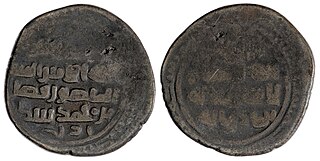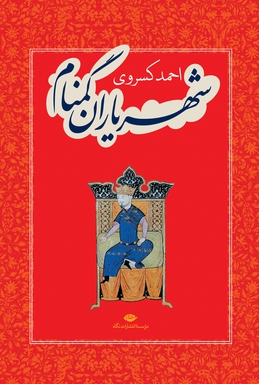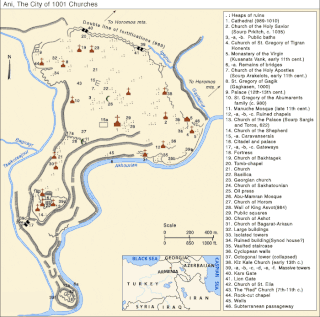
George III, of the Bagrationi dynasty, was the 8th King (mepe) of Georgia from 1156 to 1184. He became king when his father, Demetrius I, died in 1156, which was preceded by his brother's revolt against their father in 1154. His reign was part of what would be called the Georgian Golden Age – a historical period in the High Middle Ages, during which the Kingdom of Georgia reached the peak of its military power and development.

The Shaddadids were a Kurdish Sunni Muslim dynasty. who ruled in various parts of Armenia and Arran from 951 to 1199 AD. They were established in Dvin. Through their long tenure in Armenia, they often intermarried with the Bagratuni royal family of Armenia.

Qatran Tabrizi was a Persian writer, who is considered to have been one of the leading poets in 11th-century Iran. A native of the northwestern region of Azarbaijan, he spent all of his life there as well as in the neighbouring region of Transcaucasia, mainly serving as a court poet under the local dynasties of the Rawadids and Shaddadids.

Dvin was a large commercial city and the capital of early medieval Armenia. It was situated north of the previous ancient capital of Armenia, the city of Artaxata, along the banks of the Metsamor River, 35 km to the south of modern Yerevan. It is claimed it was one of the largest cities east of Constantinople prior to its destruction by the Mongols in the 13th century, but with an overall area of approximately 1sqkm, it was far smaller than many of the great cities of Asia.

Shams al-Din Ildeniz, Eldigüz or Shamseddin Eldeniz was an atabeg of the Seljuq empire and founder of the dynasty of Eldiguzids, atabegs of Azerbaijan, which held sway over Armenia, Iranian Azerbaijan, and most of northwestern Persia from the second half of the 12th century to the early decades of the 13th.

Al-Fadhl ibn Muhammad al-Shaddadi (also al-Fadl ibn Muhammad, Fadl ibn Muhammad, Fadlun ibn Muhammad, Fadhlun ibn Muhammad, or Fadl I was the Shaddadid emir of Arran from 985 to 1031. Of Kurdish origin, al-Fadhl was called "Fadhlun the Kurd" by ibn al-Athir and other Arabic historians. Al-Fadhl was the first Shaddadid emir to issue coinage, locating his mint first at Partav and was later transferred to Ganja.

Abu'l-Aswar or Abu'l-Asvar Shavur ibn Fadl ibn Muhammad ibn Shaddad was a member of the Shaddadid dynasty. Between 1049 and 1067 he was the eighth Shaddadid ruler of Arran from Ganja. Prior to that, he ruled the city of Dvin from 1022 as an autonomous lord. A capable warrior, and a wise and cunning ruler, Abu'l-Aswar was engaged in several conflicts with most of his neighbours. During his rule over Dvin, he was mostly involved in the affairs of the Armenian principalities. He collaborated with the Byzantine Empire in its conquest of the last remnants of Bagratid Armenia in 1045, but when the Byzantines later turned on him, he survived three successive offensives that sought to take Ganja. In 1049, a revolt in Ganja overthrew his infant great-great-nephew, Anushirvan. The rebels invited him to take up the family's emirate, and he moved from Dvin to Ganja. Under his rule, the Shaddadid dynasty reached its zenith. He undertook successful campaigns into Georgia and Shirvan, although the limits of Shaddadid power were exposed by his failure to take over the Emirate of Tiflis and by devastating raids by the Alans. At the same time, his reign witnessed the rapid rise of the Seljuk Empire and the extension of its control over the Transcaucasian principalities. Abu'l-Aswar became a Seljuk vassal in 1054/5. Although he gained control over the former Armenian capital of Ani through Seljuk patronage in 1065, this association also paved the way for the dynasty's decline after his death in November 1067.
Ashot ibn Abu'l-Aswar Shavur ibn Fadl was a Shaddadid prince, the second son of Abu'l-Aswar Shavur ibn Fadl. During the captivity of his older brother Fadl ibn Shavur by the Georgians in 1068, he ruled in his stead as emir of Arran for eight months, even minting coins in his own name and that of his overlord, the Seljuk Sultan Alp Arslan.
Fadlun ibn Fadl, or Fadl III was the last ruler of the Shaddadids of Arran from Ganja. He ruled from 1073 to 1075, until the Seljuk Sultan Malik-Shah removed him from power, giving him Astarabad. The realm was then absorbed by the Great Seljuqs, placing Sav-Tegin as governor of Ganja.

The Georgian–Seljuk wars, also known as Georgian Crusade, is a long series of battles and military clashes that took place from c. 1048 until 1213, between the Kingdom of Georgia and the different Seljuqid states that occupied most of Transcaucasia. The conflict is preceded by deadly raids in the Caucasus by the Turks in the 11th century, known in Georgian historiography as the Great Turkish Invasion.

Manuchihr ibn Shavur was a Shaddadid emir of Ani from c. 1072 to 1118, the first of the dynasty to rule this key city, formerly an Armenian royal capital.
Abu'l-Aswar Shavur ibn Manuchihr was the Kurdish Shaddadid emir of Ani from c. 1118 to 1124.
Fakr al-Din Shaddad ibn Mahmud was the Kurdish Shaddadid emir of Ani from sometime after 1131 until 1155.
Fadl V ibn Mahmud was a Shaddadid emir of Ani from 1155 to 1161.
Shahanshah ibn Mahmud was the Kurdish Shaddadid emir of Ani from 1164 to 1174.
Sultan ibn Mahmud was the last known Shaddadid emir of Ani reigning in parts of the dynasty's possessions from at least 1174 to c. 1199. He is known exclusively from the epigraphic data.
In the history of Azerbaijan, the Early Middle Ages lasted from the 3rd to the 11th century. This period in the territories of today's Azerbaijan Republic began with the incorporation of these territories into the Sasanian Persian Empire in the 3rd century AD. Feudalism took shape in Azerbaijan in the Early Middle Ages. The territories of Caucasian Albania became an arena of wars between the Byzantine Empire and the Sassanid Empire. After the Sassanid Empire was felled by the Arab Caliphate, Albania also weakened and was overthrown in 705 AD by the Abbasid Caliphate under the name of Arran. As the control of the Arab Caliphate over the Caucasus region weakened, independent states began to emerge in the territory of Azerbaijan.

The Forgotten Kings is a Chronicle account by Ahmad Kasravi. it is wrote since late 1928 to 1929, which includes documentary research on several At that time unknown and anonymous post-Islamic to pre-Seljuk Empire Iranian dynasties.

The Siege of Ani took place in 1124, which the Georgian army under the command of David IV the Builder liberated the ancient capital of Armenia, the city of Ani, from the Muslim emirs.

The Siege of Ani was the unsuccessful siege of the city of Ani, by the Seljukid coalition arranged by the ruler of Shah-Armens in 1161. The large Muslim army was defeat by the Georgian King George III at the gates of Ani.










